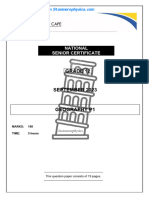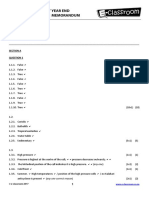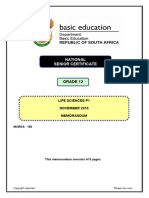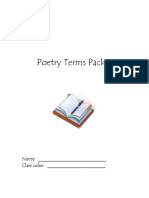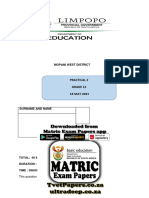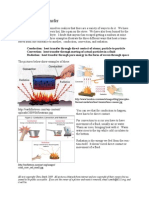Geography P1 Nov 2023 MG Eng
Geography P1 Nov 2023 MG Eng
Uploaded by
Olerato NtsimaneCopyright:
Available Formats
Geography P1 Nov 2023 MG Eng
Geography P1 Nov 2023 MG Eng
Uploaded by
Olerato NtsimaneCopyright
Available Formats
Share this document
Did you find this document useful?
Is this content inappropriate?
Copyright:
Available Formats
Geography P1 Nov 2023 MG Eng
Geography P1 Nov 2023 MG Eng
Uploaded by
Olerato NtsimaneCopyright:
Available Formats
NATIONAL
SENIOR CERTIFICATE
GRADE 12
GEOGRAPHY P1
NOVEMBER 2023
MARKING GUIDELINES
MARKS: 150
These marking guidelines consist of 10 pages.
Copyright reserved Please turn over
Geography/P1 2 DBE/November 2023
NSC – Marking Guidelines
SECTION A: CLIMATE AND WEATHER AND GEOMORPHOLOGY
QUESTION 1: CLIMATE AND WEATHER
1.1 1.1.1 Z (1)
1.1.2 Y (1)
1.1.3 Y (1)
1.1.4 Y (1)
1.1.5 Y (1)
1.1.6 Z (1)
1.1.7 Z (1) (7 x 1) (7)
1.2 1.2.1 B (1)
1.2.2 C (1)
1.2.3 A (1)
1.2.4 C (1)
1.2.5 B (1)
1.2.6 C (1)
1.2.7 B (1)
1.2.8 A (1) (8 x 1) (8)
Copyright reserved Please turn over
Geography/P1 3 DBE/November 2023
NSC – Marking Guidelines
1.3 1.3.1 Mature (1) (1 x 1) (1)
1.3.2 A well-developed cold front (2)
Reason
for stage
Wide spread rainfall to Western Cape/ Affects the Southwestern
in 1.3.1 Cape/made landfall (2)
Well-developed cold sector and warm sector (2)
Presence of the cumulonimbus cloud ahead of the cold front (2)
Steep gradient (2)
[ANY ONE] (1 x 2) (2)
1.3.3 Driven/steered by the Westerly winds (2)
Why did The mid-latitude cyclones move from west to east (2)
rainfall
spread [ANY ONE] (1 x 2) (2)
CT-
Knysna
1.3.4 Lowest -15 (1) mm
Lowest Highest- 40 (1) mm (2 x 1) (2)
and
highest
rainfall
1.3.5 Cold front (cold air) undercuts warm moist air (2)
Explain Resulting in rapid uplift of warm moist air (2)
how a
well- Rising air cools and condenses (2)
dev cold (Extensive/great vertical extent) cumulonimbus clouds develop (2)
front
result in [ANY TWO- PROCESSES] (2 x 2) (4)
heavy
rainfall
1.3.6 Will result in soil erosion (accept examples)(2)
How will Biodiversity will be destroyed (2)
the
heavy Destruction of natural habitat (accept examples) (2)
rainfall Destruction of natural vegetation (2)
negativel
y Loss of wildlife (2)
affect the Destruction of food chains /ecosystems/food webs (2)
physical
enviro Will cause mass movements (accept examples) (2)
around Fertilisers washed into the rivers (causing eutrophication) (2)
W Cape?
Will result in water pollution (accept examples) (2)
Leaching of soil nutrients (2)
(Low-lying) areas are flooded (2)
Waterlogged conditions (saturation of soil) (2)
[ANY TWO] (2 x 2) (4)
1.4 1.4.1 Presence of Coriolis force (1)
State Ocean surface temperature of at least 26,5 °C (1)
ONE
condition Calm (surface) conditions for several days/less friction (1)
for TC Presence of low (air) pressure (1)
dev Unstable atmospheric conditions (1)
Evaporation from the sea surface / rising of warm moist air (1)
Upper air divergence (1)
Latent heat (1)
[ANY ONE] (1 x 1) (1)
Copyright reserved Please turn over
Geography/P1 4 DBE/November 2023
NSC – Marking Guidelines
1.4.2 Southern (1) hemisphere (1 x 1) (1)
1.4.3 Air circulation around the low- pressure cell is clockwise (2)
Give a Forward (leading) left-hand quadrant/dangerous semi-circle is located on
reason
for SH the south-west of the tropical cyclone (2)
[ANY ONE] (1 x 2) (2)
1.4.4 A- has clear skies (1)
Cloud cover
B- dense (cumulonimbus) cloud cover (1) (2 x 1) (2)
1.4.5 At A (eye) - air is descending (heating) results in no condensation (no
Explain formation of clouds) (2)
why
there is a At B (eye wall) - air is rising (cooling) and results in condensation (the
difference
in cloud
formation of clouds) (2) (2 x 2) (4)
cover at
A and B
INSTRUCTION FOR PART MARKING- MAXIMUM OF TWO
At A (eye) - air is descending (1)
At B (eye wall) - air is rising (1)
1.4.6 Combination of the forward movement and rotation of the system (2)
Why are
strongest It has a steep pressure gradient (2)
winds in
forward left- [ANY ONE] (1 x 2) (2)
hand
quadrant ?
1.4.7
Sketch of
a TC in
its
mature
stage
996
(1)
INSTRUCTIONS FOR MARKING
(i) Pressure reading at centre of eye must not be more than 996
(range 950-996) (1)
(ii) 4 isobars indicating the correct spacing (1)
(iii) correct symbol showing the southern hemisphere (1)
(3 x 1) (3)
Copyright reserved Please turn over
Geography/P1 5 DBE/November 2023
NSC – Marking Guidelines
1.5 1.5.1 Kalahari high (1)
Coastal low (1) (2 x 1) (2)
1.5.2 B (1) (1 x 1) (1)
1.5.3 Air from the interior (KHPC) descends down the escarpment (2)
Reason The air from the KHPC moves towards the low pressure (2)
for
choice of Air is offshore towards the ocean (2)
sketch B [ANY ONE] (1 x 2) (2)
1.5.4 Air descending the escarpment (is offshore) hence dry (2)
Explain Descending air heats up resulting in no condensation (no formation of
why
cloudless clouds) (2)
conditions
found at
Descending air heats up and remaining moisture is evaporated (2)
X [ANY ONE] (1 x 2) (2)
INSTRUCTION FOR PART MARKING
Descending air (heats up) (1)
1.5.5 IMPACT
PARAGRAPH
A berg wind dries out the natural vegetation (2)
Explain
how Berg winds increases the temperature of the area and makes it vulnerable
Negative to veld fires (2)
impact of
berg The veld fires destroy the natural vegetation (2)
winds on
natural
vegetation STRATEGIES
and
suggested
Create firebreaks (2)
strategies Ensure water accessibility (accept examples) (2)
Awareness of the negative impact of veld fires (2)
Availability of emergency services (2)
Build/maintain/monitor lookout towers/warning systems (accept examples)
(2)
Education of the community (2)
Developing of wind breaks (2)
[ANY FOUR- MUST INCLUDE BOTH IMPACT AND STRATEGIES]
(4 x 2) (8)
[60]
Copyright reserved Please turn over
Geography/P1 6 DBE/November 2023
NSC – Marking Guidelines
QUESTION 2: GEOMORPHOLOGY
2.1 2.1.1 B (1)
2.1.2 G/E (1)
2.1.3 A (1)
2.1.4 C (1)
2.1.5 E (1)
2.1.6 H (1)
2.1.7 D (1)
2.1.8 F (1) (8 x 1) (8)
2.2 2.2.1 B (1)
2.2.2 C (1)
2.2.3 C (1)
2.2.4 A (1)
2.2.5 C (1)
2.2.6 C (1)
2.2.7 D (1) (7 x 1) (7)
2.3 2.3.1 A- rectangular(1)
B- dendritic (1) ( 2 x 1) (2)
2.3.2 Rock structure
Underlying
rock Jointed/faults (1)
structure Horizontally layered (1)
and type
in A [ANY ONE]
Rock type
Igneous (1)
Sedimentary (1)
[ANY ONE] (1 + 1) (2)
2.3.3 Rivers flow in joints that have 90º bends (2)
Influence of
underlying Tributaries join main streams at 90° angles (2)
rock
structure-A [ANY ONE] (1 x 2) (2)
Copyright reserved Please turn over
Geography/P1 7 DBE/November 2023
NSC – Marking Guidelines
2.3.4 High (1) (1 x 1) (1)
2.3.5 4th (2) order (1 x 2) (2)
2.3.6 The higher the stream order, the higher the drainage density (2) (1 x 2) (2)
2.3.7 The steeper slope (gradient) promotes run off (cuts more river channels)
Explain
how slope (2)
and
permeability Rocks with low permeability (impermeable) promote more run-off (less
influence
drainage infiltration) (2) (2 x 2) (4)
density-B
2.4 2.4.1 A (1) (1 x 1) (1)
2.4.2 It is flowing at a lower level (220m) (2)
Reason for
more It has captured river B (2)
erosive
power for River A erodes (headward) through the watershed (2)
river A.
Steeper gradient to watershed (220-880m) (2)
More volume of water at River A (2)
[ANY ONE] (1 x 2) (2)
2.4.3 C - Elbow of capture (1)
D - Wind gap (1) (2 x 1) (2)
2.4.4 It is a dry area (2)
Character
istic of
It has river gravels (2)
feature D It is located below the elbow of capture (2)
It is located above the misfit stream (2)
[ANY ONE] (1 x 2) (2)
2.4.5 Volume of water of the river decreases (2)
PARAGRAPH
Describe Rivers velocity/speed decreases (2)
changes River has less energy (2)
to river
E after River has less erosive ability (2)
river River will experience more deposition (2)
capture
The length of the river is shortened (2)
Stream order will decrease (2)
River will become non-perennial (accept episodic/periodic) (2)
Width of the river is reduced (2)
Size of the drainage basin decreases (2)
[ANY FOUR] (4 x 2) (8)
2.5 2.5.1 (More than) 100 million litres (1)
20% of daily use (1)
[ANY ONE] (1 x 1) (1)
2.5.2 Extract ground water (drilling boreholes) from aquifers (1)
Two plans-
extract- Alien clearing programmes (1)
improve
water Catchment restoration and maintenance (1)
security
[ANY TWO] (2 x 1) (2)
Copyright reserved Please turn over
Geography/P1 8 DBE/November 2023
NSC – Marking Guidelines
2.5.3 Less availability of ground water due to alien plants (2)
Extract-
challenges Underfunding (2)
faced when
implementi Inefficiencies (2)
ng plans
[ANY TWO] (2 x 2) (4)
2.5.4 (a) It will increase the volume of water in the dam (2)
+ impact-
removal
(b) The water table will be higher (2) (2 x 2) (4)
alien
plants on
(a)
volume
and (b)
water
table
2.5.5 There will be more water for the plants (2)
Removal
of alien
More water available for animal species (2)
plants to
improve
More water will increase aquatic habitats (2)
bio - More water will improve food supply for animal species (2)
diversity
[ANY TWO] (2 x 2) (4)
[60]
TOTAL SECTION A: 120
Copyright reserved Please turn over
Geography/P1 9 DBE/November 2023
NSC – Marking Guidelines
SECTION B
QUESTION 3: GEOGRAPHICAL SKILLS AND TECHNIQUES
3.1 3.1.1 C (1) (1 x 1) (1)
3.1.2 B (1) (1 x 1) (1)
3.1.3 D (1) (1 x 1) (1)
3.1.4 Formula: Length x Breadth
Area
calculation
(0.9 cm x 500m) x (0.7 cm x 500m) (Given)
450 (1) m x 350 (1) m
157 500 m² (1) (3 x 1) (3)
3.1.5 Formula: Vertical Interval (VI)
Average
gradient Horizontal Equivalent (HE)
VI=1 567 m - 1 420 m = 147(1) m
147 (1) (For correct substitution)
950
1 : 6.46 OR 1: 6.5 (1) (3 x 1) (3)
3.1.6 Convex slope (1) (1 x 1) (1)
3.2 3.2.1 D (1) (1 x 1) (1)
3.2.2 Cold wind drains down the valley slopes and accumulate at the valley floor
Explain
how decreasing the temperature (2) (1 x 2) (2)
katabatic
winds
influence
on temp at INSTRUCTION FOR PART MARKING- MAXIMUM OF ONE
G.
Cold wind drains down the valley slopes (1)
3.2.3 Pumpkin (1) (1 x 1) (1)
3.2.4 Frost pockets are found at the bottom of the valley (valley floor /G) (2)
Climatologi
cal reason Area where the temperatures are below freezing point /G (2)
Pumpkin can withstand temperatures below freezing point (2)
for choice
[ANY ONE] (1 x 2) (2)
3.2.5 South-westerly (1) (1 x 1) (1)
Copyright reserved Please turn over
Geography/P1 10 DBE/November 2023
NSC – Marking Guidelines
3.2.6 The highest point is to the north east/ spot height 1524 (2)
Reason for
direction of The V- shape contour lines point to areas of increasing heights to the north/
river flow
north-east (2)
The acute angles formed by the tributaries joining the main stream point in
a south-westerly direction (2)
Dam wall on the southern side (2)
[ANY ONE] (1 x 2) (2)
3.2.7 B5/H: upper (1)
LINKED
C3: middle (1)
[ANY ONE] (1 x 1) (1)
3.2.8 Upper course:
Evidence
for stage
Near the source (2)
of river Contours closely spaced (2)
Steep gradient (2)
V-shaped valleys (2)
Middle course
U shaped valley (2)
Contours far apart (2)
Gentle gradient (2)
River meanders (2)
[ANY ONE- LINKED TO 3.2.7] (1 x 2) (2)
3.1 3.3.1 B (1) (1 x 1) (1)
3.3.2 To determine if the environmental issue is getting worse (accept examples)
Explain
how
(2)
remote
sensing-
Images can be updated/monitored regularly (2)
used to Images can be analysed (2)
monitor
environm Determine possible causes (2)
ental
issues
Provide possible solutions (2)
[ANY ONE- PROCESSES] (1 x 2) (2)
3.3.3 A representation of geographical features using pixels /grid cells (2)
Definition
Raster data [CONCEPT] (1 x 2) (2)
3.3.4 Orthophoto map (1) (1 x 1) (1)
3.3.5 It is an image which shows the real dam and water it contains (2)
Why
orthophoto Tone reflects the depth (2)
map is
more Texture indicates whether there is water in the dam (2)
[ANY ONE]
realistic?
(1 x 2) (2)
TOTAL SECTION B: 30
GRAND TOTAL: 150
Copyright reserved
You might also like
- Grade 11 Practical Task Queenstown 2024 MG UpdatedDocument13 pagesGrade 11 Practical Task Queenstown 2024 MG Updatedlesslamp100% (1)
- Tourism Grade 12 Task 6.1: Practical Assessment Task (Pat) Phase 1 2023Document25 pagesTourism Grade 12 Task 6.1: Practical Assessment Task (Pat) Phase 1 2023shannonteagandupreezNo ratings yet
- Climatology Revision Activities 2020Document37 pagesClimatology Revision Activities 2020Tumi100% (1)
- Climate and Weather - Learner Activities 2024Document68 pagesClimate and Weather - Learner Activities 2024Kamogelo PromiseNo ratings yet
- 12 - Poetry Unit - 2018-2019 - Student HandoutsDocument18 pages12 - Poetry Unit - 2018-2019 - Student HandoutsOlerato NtsimaneNo ratings yet
- Grade 12 NSC Geography P2 (English) Preparatory Examination Possible AnswersDocument19 pagesGrade 12 NSC Geography P2 (English) Preparatory Examination Possible Answersnthakotebza629No ratings yet
- LFSC Autumn Camp 2023 Term 1 DrillingDocument23 pagesLFSC Autumn Camp 2023 Term 1 Drillingntandolamar41No ratings yet
- GEOGRAPHY GR12 MEMO JUNE 2022 - EnglishDocument9 pagesGEOGRAPHY GR12 MEMO JUNE 2022 - EnglishAllen MaropengNo ratings yet
- GEOGRAPHY P1 MEMO GR11 NOV 2023 - EnglishDocument10 pagesGEOGRAPHY P1 MEMO GR11 NOV 2023 - Englishmakaylenmunusamy3No ratings yet
- EC Geography Grade 12 September 2023 P1 and MemoDocument29 pagesEC Geography Grade 12 September 2023 P1 and Memomalambulempendulo32No ratings yet
- Life Orientation September 2023 EngDocument9 pagesLife Orientation September 2023 EngmadzhutatakalaniNo ratings yet
- TOURISM GR11 QP NOV2022 - EnglishDocument22 pagesTOURISM GR11 QP NOV2022 - EnglishPrince Good luckNo ratings yet
- Tropical Cyclone Grade 12Document24 pagesTropical Cyclone Grade 12fortunemohlala111No ratings yet
- Tourism Gr11 QP Nov2020 EnglishDocument25 pagesTourism Gr11 QP Nov2020 Englishreconcilemalele3No ratings yet
- EC Geography Grade 11 November 2020 P1 and MemoDocument25 pagesEC Geography Grade 11 November 2020 P1 and MemoKamogeloNo ratings yet
- Lo Controlled Test Term 2 GR 11Document9 pagesLo Controlled Test Term 2 GR 11sa961296No ratings yet
- MP Geo p2 Marking Guidelines 2023Document16 pagesMP Geo p2 Marking Guidelines 2023Masentle MonicaNo ratings yet
- Excel in Mapwork Teacher Guide 2023Document20 pagesExcel in Mapwork Teacher Guide 2023kamohelomashaba.kmNo ratings yet
- Secondary School Improvement Programme Ssip 2016 Geography Revised Learner Notes Sessions Settlement Geography Grade 12 CompressDocument37 pagesSecondary School Improvement Programme Ssip 2016 Geography Revised Learner Notes Sessions Settlement Geography Grade 12 Compressscjdtzhyk6No ratings yet
- English HL P2 MemoDocument22 pagesEnglish HL P2 Memovmgcina55100% (1)
- 5 Geography Grade 12 Urban Settlements PPT'sDocument26 pages5 Geography Grade 12 Urban Settlements PPT'sMkhanyisi BhebheNo ratings yet
- gr11 Geography Paper 1 Final Exam MemoDocument14 pagesgr11 Geography Paper 1 Final Exam MemoMokone BestenNo ratings yet
- Last Push Geomorphology Memo FinalDocument6 pagesLast Push Geomorphology Memo FinalDarlingtonNo ratings yet
- LFSC Gr11 June Memo 2023 ENGDocument17 pagesLFSC Gr11 June Memo 2023 ENGDoryson CzzleNo ratings yet
- p2 Geography Annexture TestDocument6 pagesp2 Geography Annexture TestmtshayizukisaNo ratings yet
- 2024 Lo Grade 12 Scope Controlled TestDocument4 pages2024 Lo Grade 12 Scope Controlled Testtapopaj919No ratings yet
- Sepedi HL P2 Nov 2017 MemoDocument24 pagesSepedi HL P2 Nov 2017 MemoLENCELORDNo ratings yet
- Map Work Booklet Marking GuidelineDocument34 pagesMap Work Booklet Marking Guidelinekmahlangu391No ratings yet
- Geography Grade 12 Term 1 Week 1 - 2021 1Document7 pagesGeography Grade 12 Term 1 Week 1 - 2021 14z2r2yvgpq100% (1)
- Prelim Exam Grade 12 Paper 2 MEMODocument24 pagesPrelim Exam Grade 12 Paper 2 MEMOhonestlyiloveherNo ratings yet
- MATHS LIT P2 MEMO GR11 NOV2020 - EnglishDocument5 pagesMATHS LIT P2 MEMO GR11 NOV2020 - EnglishFezile ManyangaNo ratings yet
- CAT Revision Package GR 12 - (FINAL - IF)Document26 pagesCAT Revision Package GR 12 - (FINAL - IF)jennyNo ratings yet
- HISTORY P1 SEPTEMBER 2023 GRADE 12 QP NewDocument9 pagesHISTORY P1 SEPTEMBER 2023 GRADE 12 QP NewhonestlyiloveherNo ratings yet
- Grade 12 Exemplar Sba Tasks - 2024Document63 pagesGrade 12 Exemplar Sba Tasks - 2024adetona19goldNo ratings yet
- MP Economics Grade 12 September 2023 P1 and MemoDocument32 pagesMP Economics Grade 12 September 2023 P1 and Memonkatekodawn72No ratings yet
- Climate Revision Lectures Notes 2021Document26 pagesClimate Revision Lectures Notes 2021smangalisoyonela8No ratings yet
- Gr11 Geog p2 n16 Memo EngDocument10 pagesGr11 Geog p2 n16 Memo EngThato MotlhabaneNo ratings yet
- Geography p1 Prep Sept 2023 Memo Eng Free StateDocument11 pagesGeography p1 Prep Sept 2023 Memo Eng Free Statemothibakgomotumisang882No ratings yet
- Winter Revision - Geography Grade - 12 - Term - 2 - Activities - JIT1656014505594Document47 pagesWinter Revision - Geography Grade - 12 - Term - 2 - Activities - JIT1656014505594mananantombi00No ratings yet
- Settlement Geography Grade 12 ReduceDocument196 pagesSettlement Geography Grade 12 ReduceMalume TransportationNo ratings yet
- GR 12 Settlement Geography Part 6 Summaries Urban SettlementsDocument8 pagesGR 12 Settlement Geography Part 6 Summaries Urban SettlementsAlefher Buendia PatriaNo ratings yet
- EFAL SUBJECT POLICY GRADES 10 - 12 2023 Ver 2Document22 pagesEFAL SUBJECT POLICY GRADES 10 - 12 2023 Ver 2blessingtebogo86No ratings yet
- Source Based and Essay Questions GuidelinesDocument18 pagesSource Based and Essay Questions Guidelinesu20036929No ratings yet
- Life Sciences P1 Nov 2011 Memo Eng Version 2 FinalDocument12 pagesLife Sciences P1 Nov 2011 Memo Eng Version 2 Finalbellydanceafrica9540No ratings yet
- A Sleeping Black BoyDocument8 pagesA Sleeping Black Boyneo909930No ratings yet
- IsiZulu HL P1 Nov 2019 MemoDocument10 pagesIsiZulu HL P1 Nov 2019 MemoZamambo MkhizeNo ratings yet
- Draft MTG Efal Poetry Grade 12Document86 pagesDraft MTG Efal Poetry Grade 12azenhajoaneNo ratings yet
- LFSC GRD 11 p1 Revision Booklet (Section A) - Teacher's Copy 062033Document31 pagesLFSC GRD 11 p1 Revision Booklet (Section A) - Teacher's Copy 062033Sekgobela M. MirandaNo ratings yet
- Grade 12 Economic Geography Notes 2024 EcDocument36 pagesGrade 12 Economic Geography Notes 2024 EcmzolimlanduNo ratings yet
- Lo Grade 11 PLC Paper 2023Document9 pagesLo Grade 11 PLC Paper 2023phedum9No ratings yet
- English Fal P1 GR11 QP Nov 2022Document12 pagesEnglish Fal P1 GR11 QP Nov 2022o2546439No ratings yet
- 2024 Mlit Grade 12 Term 2 AssignmentDocument9 pages2024 Mlit Grade 12 Term 2 Assignmentenhlejobe60% (1)
- Last Push Climatology Memo FinalDocument9 pagesLast Push Climatology Memo FinalDarlingtonNo ratings yet
- Geography P2 Nov 2022 MG EngDocument9 pagesGeography P2 Nov 2022 MG EngZanele MushwanaNo ratings yet
- Geography Grade 12 Term 1 Week 4 - 2021Document13 pagesGeography Grade 12 Term 1 Week 4 - 2021tshegomatsididi0505No ratings yet
- Mathematical Literacy GR 11 Paper 1Document8 pagesMathematical Literacy GR 11 Paper 1w82sm6kw7vNo ratings yet
- English Fal June Exam Grade 12 English Fal 2023 PDFDocument27 pagesEnglish Fal June Exam Grade 12 English Fal 2023 PDFlebonhlawuleko21No ratings yet
- GR 11 Tourism - Term 2 - Foreign Exchange - Revision Questions - EcdoeDocument7 pagesGR 11 Tourism - Term 2 - Foreign Exchange - Revision Questions - Ecdoeshirindzimbongeni2No ratings yet
- Dna Test 1 MemoDocument5 pagesDna Test 1 Memondlovusenamile401No ratings yet
- Geography Grade 12 Learner Activities ECONOMIC TERM3 For 2020 Notes and SolutionsDocument63 pagesGeography Grade 12 Learner Activities ECONOMIC TERM3 For 2020 Notes and SolutionsspororamsNo ratings yet
- geography p1 nov 2023 memoDocument11 pagesgeography p1 nov 2023 memonhlabathiithembeka314No ratings yet
- Mine ManagerDocument1 pageMine ManagerOlerato NtsimaneNo ratings yet
- List of accredited accommodation Tygerberg 2024 (1)Document12 pagesList of accredited accommodation Tygerberg 2024 (1)Olerato NtsimaneNo ratings yet
- Energy and Momentum Unit SummaryDocument2 pagesEnergy and Momentum Unit SummaryOlerato NtsimaneNo ratings yet
- Partitioning 2Document3 pagesPartitioning 2Olerato NtsimaneNo ratings yet
- Junior Sketchbook AssignmentsDocument1 pageJunior Sketchbook AssignmentsOlerato NtsimaneNo ratings yet
- Enghl p3 Gr11 Memo Nov 2022Document10 pagesEnghl p3 Gr11 Memo Nov 2022Olerato NtsimaneNo ratings yet
- Body SystemsDocument2 pagesBody SystemsOlerato NtsimaneNo ratings yet
- Artist Statement RecipeDocument4 pagesArtist Statement RecipeOlerato NtsimaneNo ratings yet
- Gr12 LSC Topic Test MG Eng June 2024Document5 pagesGr12 LSC Topic Test MG Eng June 2024Olerato NtsimaneNo ratings yet
- Life Science Post Test 26344Document10 pagesLife Science Post Test 26344Olerato NtsimaneNo ratings yet
- GR 10 12 Term 1 2 2019 Ps Trainers GuideDocument22 pagesGR 10 12 Term 1 2 2019 Ps Trainers GuideOlerato NtsimaneNo ratings yet
- Life Orientation Grade 12 ProjectDocument8 pagesLife Orientation Grade 12 ProjectOlerato NtsimaneNo ratings yet
- Geography P2 Nov 2023 MG EngDocument12 pagesGeography P2 Nov 2023 MG EngOlerato NtsimaneNo ratings yet
- LIFE SCIENCES Practical Task 1 Grade 12 Feb 2023Document6 pagesLIFE SCIENCES Practical Task 1 Grade 12 Feb 2023Olerato Ntsimane100% (2)
- English GR 11 HL MEMO Paper 1Document8 pagesEnglish GR 11 HL MEMO Paper 1Olerato NtsimaneNo ratings yet
- Life Sciences P1 Nov 2016 Memo EngDocument9 pagesLife Sciences P1 Nov 2016 Memo EngOlerato NtsimaneNo ratings yet
- Geography P2 Nov 2023 EngDocument18 pagesGeography P2 Nov 2023 EngOlerato NtsimaneNo ratings yet
- Life Sciences P2 Nov 2023 MG EngDocument11 pagesLife Sciences P2 Nov 2023 MG EngOlerato NtsimaneNo ratings yet
- Life Sciences P1 Nov 2023 MG EngDocument10 pagesLife Sciences P1 Nov 2023 MG EngOlerato NtsimaneNo ratings yet
- Study Master Gr12 English Grammar and VocabularyDocument63 pagesStudy Master Gr12 English Grammar and VocabularyOlerato NtsimaneNo ratings yet
- PP 31 The Atmosphere and Climate ChangeDocument97 pagesPP 31 The Atmosphere and Climate ChangeOlerato NtsimaneNo ratings yet
- Poetry Terms PacketDocument10 pagesPoetry Terms PacketOlerato NtsimaneNo ratings yet
- 2021 LFSC Prac 2 GR 12Document8 pages2021 LFSC Prac 2 GR 12Olerato NtsimaneNo ratings yet
- Ls GR 12 Session 10protein Synt and Dna FingerprintingDocument11 pagesLs GR 12 Session 10protein Synt and Dna FingerprintingOlerato NtsimaneNo ratings yet
- Periodic Table, Group 2 and The Halogens 1 QPDocument13 pagesPeriodic Table, Group 2 and The Halogens 1 QPmalakNo ratings yet
- Earthquake & SeismologyDocument43 pagesEarthquake & Seismologymuktha mukuNo ratings yet
- 02 Chapter 3 - Weight Volume RelationshipsDocument42 pages02 Chapter 3 - Weight Volume RelationshipsLeandrow BacolodNo ratings yet
- Raw Material FixDocument3 pagesRaw Material FixhtranggonoNo ratings yet
- Worksheet 5Document2 pagesWorksheet 5joanne0% (1)
- Science Q4M2Document41 pagesScience Q4M2once twiceNo ratings yet
- (Daily & Ehrlich, 1992) Population, Sustainability, and Earth's Carrying CapacityDocument11 pages(Daily & Ehrlich, 1992) Population, Sustainability, and Earth's Carrying CapacityOscar Leonardo Aaron Arizpe VicencioNo ratings yet
- Ocean CleanDocument12 pagesOcean CleanSai Venkatesh VadapalliNo ratings yet
- Analysis of Rain Fall Onset and Recession For DecisionDocument14 pagesAnalysis of Rain Fall Onset and Recession For DecisionJemal KasimNo ratings yet
- Waste Heat Recovery System For Cement PlantDocument6 pagesWaste Heat Recovery System For Cement PlantandrowreganNo ratings yet
- Phillip's Optimised Cascade Process ExplainedDocument3 pagesPhillip's Optimised Cascade Process ExplainedDavid PierreNo ratings yet
- Erwin Schrodinger, Werner Heisenberg, Louis de Broglie Et. AlDocument1 pageErwin Schrodinger, Werner Heisenberg, Louis de Broglie Et. AlBing Sepe CulajaoNo ratings yet
- MDEA-CO2 BKPDocument83 pagesMDEA-CO2 BKPAnonymous zwSP5gvNo ratings yet
- Valtam DataDocument2 pagesValtam DataSantosh ZunjarNo ratings yet
- Science Project: Name: Castorico, Shaira Grace C. Section: BAED2111-72Document28 pagesScience Project: Name: Castorico, Shaira Grace C. Section: BAED2111-72amaeamee ameaimeNo ratings yet
- 9 Types of Heat TransferDocument3 pages9 Types of Heat TransfergopishereNo ratings yet
- Solar Panel Manufacturers - Solar Panel System - IstutiDocument6 pagesSolar Panel Manufacturers - Solar Panel System - IstutiistutisolarservicesNo ratings yet
- Conservacion de La EnergiaDocument4 pagesConservacion de La EnergiaDaniel GonzalesNo ratings yet
- Types of Boiler: Water Tube Boiler Fire Tube Boiler Fire Tube Boiler Water Tube BoilerDocument4 pagesTypes of Boiler: Water Tube Boiler Fire Tube Boiler Fire Tube Boiler Water Tube BoileradelNo ratings yet
- Class Note On Combustion ProcessesDocument5 pagesClass Note On Combustion ProcessesIfiok UsoroNo ratings yet
- SF-0016.1 Steam Turbine Abradables ENDocument12 pagesSF-0016.1 Steam Turbine Abradables ENMuhammad IchsanNo ratings yet
- Er. Alok Ranjan: The Umang Classes, Infront of RLSY College, Shahpur, Aurangabad (Bihar) - Call/Whatsapp - 8002616622Document1 pageEr. Alok Ranjan: The Umang Classes, Infront of RLSY College, Shahpur, Aurangabad (Bihar) - Call/Whatsapp - 8002616622Alok RanjanNo ratings yet
- GEOL 1001 Exam 1 StudyDocument2 pagesGEOL 1001 Exam 1 StudytiglawNo ratings yet
- The World Withouy UsDocument3 pagesThe World Withouy UsDorina DanilaNo ratings yet
- Sustainable Architecture PDFDocument10 pagesSustainable Architecture PDFBrylle De GuzmanNo ratings yet
- Unit 14 Environmental ChemistryDocument7 pagesUnit 14 Environmental Chemistrygyogi1989No ratings yet
- Q2 Grade8 EarthSpace SUMMATIVETEST 3 2021Document1 pageQ2 Grade8 EarthSpace SUMMATIVETEST 3 2021De MurielNo ratings yet
- Diagnostic Test in Science Grade 8 School Year 2018-2019: Schools Division Office Quezon CityDocument5 pagesDiagnostic Test in Science Grade 8 School Year 2018-2019: Schools Division Office Quezon CitydoidoiNo ratings yet
- Branch Concerning Field: Dealing DealsDocument3 pagesBranch Concerning Field: Dealing DealsShashikant JaisinghaNo ratings yet
- Fractional Distillattion: By: Aman Kumar To: Dr. ShivaniDocument16 pagesFractional Distillattion: By: Aman Kumar To: Dr. ShivanimohitNo ratings yet









